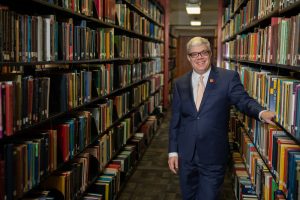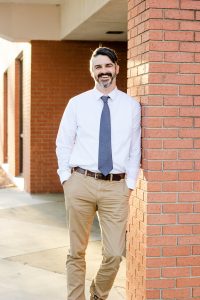To meet the challenges of COVID-19, faculty and staff at Clemson University leveraged open practices to tap into broader networks, open new channels of communication, and share information in new ways.
 “This was a pinnacle moment for open science and it is not going to go away,” says Christopher Cox, dean of libraries at the South Carolina public university. “It definitely made the world a smaller place. People aren’t working alone at their universities. They are working in teams – and they aren’t just on their campuses or in their states. There are international teams.”
“This was a pinnacle moment for open science and it is not going to go away,” says Christopher Cox, dean of libraries at the South Carolina public university. “It definitely made the world a smaller place. People aren’t working alone at their universities. They are working in teams – and they aren’t just on their campuses or in their states. There are international teams.”
Sharing best practices on reopenings
Clemson has been a leader in reopening its campus, testing students, and minimizing spread of the virus. In developing its strategy, the university’s COVID-19 modeling team used preprint servers to both gather information on SARS-CoV-2 transmission dynamics and to post its research prior to publication in a peer-reviewed journal.
The urgency of the situation meant that universities everywhere were eager for promising information on what works. Last year, the Clemson team published two manuscripts on the preprint server medrXiv: Reopening universities during the COVID-19 pandemic: A testing strategy to minimize active cases and delay outbreaks and The urgent need for phased university reopenings to mitigate the spread of COVID-19 and conserve institutional resources: A modeling study. The papers have been downloaded hundreds of times, picked up by news outlets, and cited in policy guidelines of other universities and other research articles.
 While the team’s work will also appear in an article in the journal Lancet later this spring, if the researchers had waited for publication in peer-reviewed journals, the findings may have never reached the targeted audience at a point when they were needed the most, according to Clemson’s lead epidemiologist Corey Kalbaugh, assistant professor in the Department of Public Health Sciences. He helped coordinate the modeling team that worked around the clock to craft policies and carry out practices to keep students on campus safe.
While the team’s work will also appear in an article in the journal Lancet later this spring, if the researchers had waited for publication in peer-reviewed journals, the findings may have never reached the targeted audience at a point when they were needed the most, according to Clemson’s lead epidemiologist Corey Kalbaugh, assistant professor in the Department of Public Health Sciences. He helped coordinate the modeling team that worked around the clock to craft policies and carry out practices to keep students on campus safe.
Clemson’s decision to delay the start of the fall 2020 semester until September 21, phasing in the reopening, and requiring testing prior to arrival proved to be a smart approach. Also, weekly COVID testing of students (at first nasal, then saliva) and targeted follow up helped pinpoint outbreaks and prevent spread of the illness. In the fall, there were about 7,000 students living on campus at Clemson, another 15,000 off campus. Due to Clemson’s testing strategy and mitigation efforts, infection rates remained below 3 percent and zero hospitalization for COVID-19.
“I learned when the science team, university leaders and operations personal work in concert and listen to each other, it’s remarkable what can be achieved,” says Kalbaugh. “We are notorious in the scholarly world for being isolated. Covid presented an opportunity to meet people across disciplines and work together in ways we never had before in an academic setting.”
“I hope in the long term, we continue this approach with every problem we handle. The pandemic helped us see the positive that can come from the value of coming together and working in collaboration.”
Tracking social media trends and COVID-19
 The social and economic destabilization caused by COVID-19 has produced a range of emotions in people, including fear, anxiety, depression, grief, and even hostility. Matt Costello, assistant professor in Clemson’s department of sociology, anthropology and criminal justice, is specifically examining hostility expressed in social media online related to the pandemic that targets people based on race/ethnicity, age, social class, immigrant status and political ideology.
The social and economic destabilization caused by COVID-19 has produced a range of emotions in people, including fear, anxiety, depression, grief, and even hostility. Matt Costello, assistant professor in Clemson’s department of sociology, anthropology and criminal justice, is specifically examining hostility expressed in social media online related to the pandemic that targets people based on race/ethnicity, age, social class, immigrant status and political ideology.
The project involves tracking text and pictures from Twitter, which is publicly available, over two years. Researchers will curate the information into a large-scale data set that will be made open to the public. Funding for the study comes from the National Science Foundation and making all results and data open was part of Costello’s proposal.
Costello hopes to provide insight into cyber-hostility trends and how online dialogue around COVID-19 evolves over time. He is looking at whether politicized references to the pandemic in speeches offline – such as President Trump’s calling COVID-19 the China virus – correlated with spikes in cyber hate language toward Asians online. Costello is exploring references to China on Twitter over time to see if the pandemic has any lasting effects on trends in vitriolic language used. He also wants to find out if those engaged in hateful COVID-19 related posts have a history of cyber-hostility or if their actions were connected to the pandemic.
“Data sharing is a beneficial practice,” Costello says. “From my standpoint, I have a very specific idea of what to do with this data, but I know there are others who might look at my dataset and want to do something entirely different. Making data publicly available opens up new possibilities – and this is a very popular subject. It can be useful to different teams.”
To conduct the research, Costello is working with colleagues in the School of Computing to pool all the data from Twitter and make it publicly available for others to reuse and build upon for future research. In addition to pitching to an academic journal for publication, Costello plans to share findings with others at conferences.
Easily accessing PubMed COVID-19 research
Last September, faculty in the Clemson School of Nursing learned of a new R1 research project grant application on community interventions to address the consequences of the COVID-19 pandemic among health disparity and vulnerable populations. A team of 13 researchers from various departments worked together on a proposal to study the interaction of sickle cell disease (SCD) and coronavirus.
As the team began to gather literature to summarize what was known on the topic, they turned to PubMed Central. They found a wealth of easily accessible, open access material available on the database maintained by the National Institutes of Health. (Last spring, NIH created a COVID-19 Open Research Database – CORD19 –as a free resource with scholarly articlesrelated to the virus.)
“It was a delight to have instant access to the world with all the latest on COVID and SCD. The information was readily available and abundant,” says Lucia Gonzales, associate director of research in the Clemson University School of Nursing. She pulled about 25 articles that were useful in laying the foundation for the grant proposal and designing the interventions. “The benefits were amazing. As a researcher, I had reliable and quantifiable statistics on frequencies of symptoms being experienced and on which approaches were working to support the necessary behavior changes to promote COV
information was readily available and abundant,” says Lucia Gonzales, associate director of research in the Clemson University School of Nursing. She pulled about 25 articles that were useful in laying the foundation for the grant proposal and designing the interventions. “The benefits were amazing. As a researcher, I had reliable and quantifiable statistics on frequencies of symptoms being experienced and on which approaches were working to support the necessary behavior changes to promote COV
ID-prevention.”
Gonalzes says her clinical colleagues were able to document the effects of medicinal and other treatments almost in real time – and patient recipients benefitted from this knowledge sharing.
The team turned in its grant application in December and hopes to learn if their proposal will be funded in the coming months.
This story about Clemson’s experience is part of ongoing SPARC coverage on the impact of the pandemic on open practices. For more, see:
Canadian Health Geographers Share Virus Risk Maps with Public Before Publishers
University of Toronto Researchers Accelerate Embrace of Open Science
CEPI’s Equitable Access Policies Address Global Health Inequities.